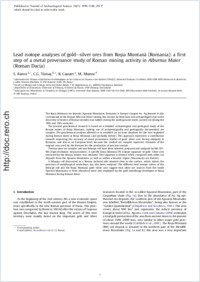Lead isotope analyses of gold–silver ores from Roşia Montană (Romania): a first step of a metal provenance study of Roman mining activity in Alburnus Maior (Roman Dacia)
DOKPE
- Baron, S. Laboratoire des Travaux et Recherches Archéologiques sur les Cultures, les Espaces et les Sociétés (TRACES), Université Toulouse, France
- Tămaş, Calin-Gabriel Faculty of Biology and Geology, University Babeş-Bolyai, Cluj-Napoca, Romania - Department of Geosciences, University of Fribourg, Switzerland
- Cauuet, B. Laboratoire des Travaux et Recherches Archéologiques sur les Cultures, les Espaces et les Sociétés (TRACES), Université Toulouse, France
- Munoz, M. Laboratoire des Mécanismes et Transferts en Géologie (LMTG), Université Paul-Sabatier, Toulouse, France
-
17.12.2010
Published in:
- Journal of Archaeological Science. - 2011, vol. 38, no. 5, p. 1090-1100
Mining archaeology
Mineralogy
Geochemistry
Chrono- and geo-referenced materials
Lead isotopes
Metal provenance
Roşia Montană
English
The Roşia Montană ore deposit (Apuseni Mountains, Romania) is Europe’s largest Au–Ag deposit. It also corresponds to the Roman Alburnus Maior mining site, known by historians and archaeologists due to the discovery of dozens of Roman wooden wax tablets during the underground works carried out during the 18th and 19th centuries.The present geochemical research is based on a detailed archaeological and geological study of the Roman mines at Roşia Montană, making use of archaeologically and geologically documented ore samples. The geochemical analyses allowed us to establish an accurate database for the ores exploited during Roman times at Roşia Montană (and probably before). This approach represents a contribution towards improving the accuracy of metal provenance studies of gold–silver ores during antiquity in Romania, and also at an European level, because the studied ore samples represent remnants of the original ores used by the Romans for the production of precious metals.Twenty-nine ore samples and one litharge roll have been selected, prepared and analysed by MC-ICP-MS (high-resolution measurements). A specific Roşia Montană Pb isotope signature of gold–silver ores extracted by the Roman miners was obtained. This signature is distinct when compared with other ore deposits from the Apuseni Mountains, as well as within a broader region (Maramureş ore district).A litharge roll discovered in a Roman inclined adit situated close to the surface, which attests the presence of metallurgical workshops, has also been analysed. The different lead isotope values of the litharge roll and the Roşia Montană gold–silver ores suggest that other ore sources from the South Apuseni Mountains or from elsewhere were also employed by the gold metallurgy developed at Roşia Montană during Roman times.
- Faculty
- Faculté des sciences et de médecine
- Department
- Département de Géosciences
- Language
-
- English
- Classification
- Archeology
- License
- License undefined
- Identifiers
-
- RERO DOC 22514
- DOI 10.1016/j.jas.2010.12.004
- Persistent URL
- https://folia.unifr.ch/unifr/documents/301818
Statistics
Document views: 113
File downloads:
- tam_lia.pdf: 362
